
Lingzhi, Ganoderma sichuanense, also known as reishi or Ganoderma lingzhi is a polypore fungus native to East Asia belonging to the genus Ganoderma.
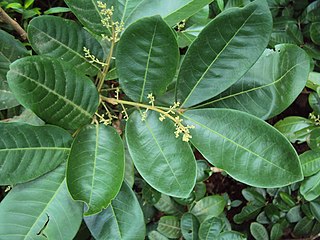
Aglaia is a genus of 121 recognised species of woody dioecious trees in the mahogany family Meliaceae. They occur in the subtropical and tropical forests of Southeast Asia, northern Australia and the Pacific.
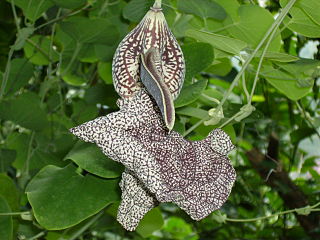
Aristolochia is a large plant genus with over 500 species that is the type genus of the family Aristolochiaceae. Its members are commonly known as birthwort, pipevine or Dutchman's pipe and are widespread and occur in the most diverse climates. Some species, like A. utriformis and A. westlandii, are threatened with extinction.

Rhamnus is a genus of about 140 accepted species of shrubs or small trees, commonly known as buckthorns, in the family Rhamnaceae. Its species range from 1 to 10 m tall and are native mainly in east Asia and North America, but found throughout the temperate and subtropical Northern Hemisphere, and also more locally in the subtropical Southern Hemisphere in parts of Africa and South America. One species, the common buckthorn, is able to flourish as an invasive plant in parts of Canada and the U.S., where it has become naturalized.

Strychnos nux-vomica, the strychnine tree, also known as nux vomica, poison fruit, semen strychnos, and quaker buttons, is a deciduous tree native to India and to southeast Asia. It is a medium-sized tree in the family Loganiaceae that grows in open habitats. Its leaves are ovate and 5–9 centimetres (2–3.5 in) in size. It is known for being the natural source of the extremely poisonous compound strychnine.

Phellodendron amurense is a species of tree in the family Rutaceae, commonly called the Amur cork tree. It is a major source of huáng bò, one of the 50 fundamental herbs used in traditional Chinese medicine. The Ainu people used this plant, called shikerebe-ni, as a painkiller. It is known as hwangbyeok in Korean and (キハダ) kihada in Japanese.
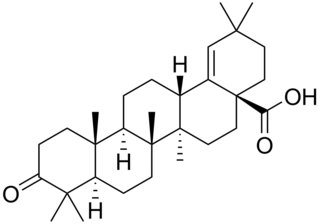
Moronic acid is a natural triterpene. Moronic acid can be extracted from Rhus javanica, a sumac plant traditionally believed to hold medicinal applications. The molecule has also been extracted from mistletoe.
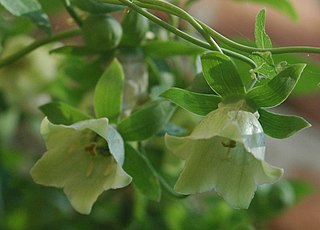
Codonopsis pilosula, also known as Dangshen, is a perennial species of flowering plant in the bellflower family. It is native to Asia, where it grows in forests, meadows, and scrub.

Choerospondias axillaris, known in English as the Nepali hog plum, is a tree in the family Anacardiaceae. It is the sole species in genus Choerospondias. It is native to the Himalayas, Indochina, southern and north-central China, Taiwan, and Japan. It is a common fruit in Nepal and Bhutan, called lapsi and aamli in the Nepali-speaking community.

Emodin (6-methyl-1,3,8-trihydroxyanthraquinone) is a chemical compound, of the anthraquinone family, that can be isolated from rhubarb, buckthorn, and Japanese knotweed. Emodin is particularly abundant in the roots of the Chinese rhubarb, knotweed and knotgrass as well as Hawaii ‘au‘auko‘i cassia seeds or coffee weed. It is specifically isolated from Rheum palmatum L. It is also produced by many species of fungi, including members of the genera Aspergillus, Pyrenochaeta, and Pestalotiopsis, inter alia. The common name is derived from Rheum emodi, a taxonomic synonym of Rheum australe, and synonyms include emodol, frangula emodin, rheum emodin, 3-methyl-1,6,8-trihydroxyanthraquinone, Schüttgelb (Schuttgelb), and Persian Berry Lake.
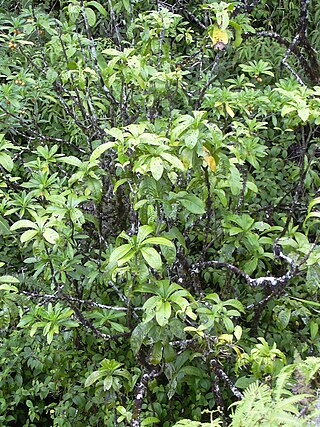
Ceodes umbellifera, synonym Pisonia umbellifera, commonly known as the birdlime tree or bird catcher tree, is a species of plant in the Nyctaginaceae family. The evergreen shrub has soft wood, small pink or yellow flowers, and produces cavate brown fruit throughout the period March to April. The species has been categorized under different genera in its documented lifetime, being reallocated between Pisonia and Ceodes. Its former genus, Pisonia, is named after a Dutch scientist, Willem Piso, and umbellifera is derived from Latin umbelliferum, denoting the species' big, 'shade-carrying' foliage.

Huáng bǎi, huáng bó or huáng bò is one of the fifty fundamental herbs of traditional Chinese medicine. Known also as Cortex Phellodendri, it is the bark of one of two species of Phellodendron tree: Phellodendron amurense or Phellodendron chinense.
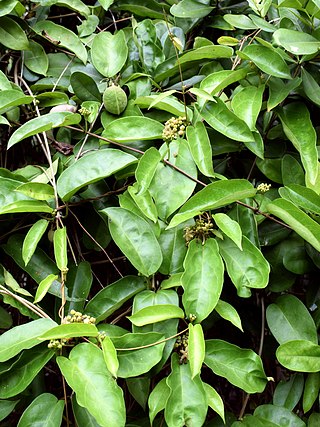
Sarcolobus globosus is a twining shrub native to tropical regions of Asia including India, China, Thailand, Malaysia, Myanmar-Burma, the Philippines and Indonesia.
Hansenia weberbaueriana, synonym Notopterygium incisum, is a species of flowering plant in the family Apiaceae, native from northeastern Tibet to central China. It is known as the notopterygium root. Its root and rhizome parts of the plant have long been used in traditional Chinese medicine, and the plant continues to be thoroughly studied to this day. As a result of its use, it has become endangered due to excessive cultivation for use in commercial products.
Elemenes are a group of closely related natural chemical compounds found in a variety of plants. The elemenes, which include α-, β-, γ-, and δ-elemene, are structural isomers of each other and are classified as sesquiterpenes. The elemenes contribute to the floral aromas of some plants, and are used as pheromones by some insects.

Cassia javanica, also known as Java cassia, pink shower, apple blossom tree and rainbow shower tree, is a species of tree in the family Fabaceae. Its origin is in Southeast Asia, but it has been extensively grown in tropical areas worldwide as a garden tree owing to its beautiful crimson and pink flower bunches.
Rheum lhasaense is a plant from eastern Tibet belonging to the genus Rheum in family Polygonaceae. It is a mid-sized rhubarb species with triangular leaves and spherical fruit.

Saposhnikovia is a monotypic genus of flowering plants in the family Apiaceae. Its only species is Saposhnikovia divaricata, known as fángfēng防風 in Chinese, bangpung in Korean, and siler in English. The plant is still frequently referenced under the obsolete genus name Ledebouriella in many online sources devoted to traditional Chinese medicine. It was first described as Stenocoelium divaricatum by Nikolai Turczaninow in 1844, and transferred to Saposhnikovia in 1951.

Goniothalamus amuyon is a species of plant in the family Annonaceae. It is native to the Philippines. In the provinces of Batangas and Bohol it is commonly referred to as amúyong or amúyon. In the Ilocos region and Pangasinan province it is commonly referred to as sagiát. Francisco Manuel Blanco, the Spanish Augustinian friar and botanist who first formally described the species using the basionym Uvaria amuyon, named it after its Tagalog name.

















